今天講解如何用Python/ target=_blank class=infotextkey>Python爬取芒果TV、騰訊視頻、B站、愛奇藝、知乎、微博這幾個常見常用的影視、輿論平臺的彈幕和評論,這類爬蟲得到的結果一般用于娛樂、輿情分析,如:新出一部火爆的電影,爬取彈幕評論分析他為什么這么火;微博又出大瓜,爬取底下評論看看網友怎么說,等等這娛樂性分析。
本文爬取一共六個平臺,十個爬蟲案例,如果只對個別案例感興趣的可以根據:芒果TV、騰訊視頻、B站、愛奇藝、知乎、微博這一順序進行拉取觀看。完整的實戰源碼已在文中,我們廢話不多說,下面開始操作!
芒果TV
本文以爬取電影《懸崖之上》為例,講解如何爬取芒果TV視頻的彈幕和評論!
網頁地址:
https://www.mgtv.com/b/335313/12281642.html?fpa=15800&fpos=8&lastp=ch_movie
彈幕
分析網頁
彈幕數據所在的文件是動態加載的,需要進入瀏覽器的開發者工具進行抓包,得到彈幕數據所在的真實url。當視頻播放一分鐘它就會更新一個json數據包,里面包含我們需要的彈幕數據。
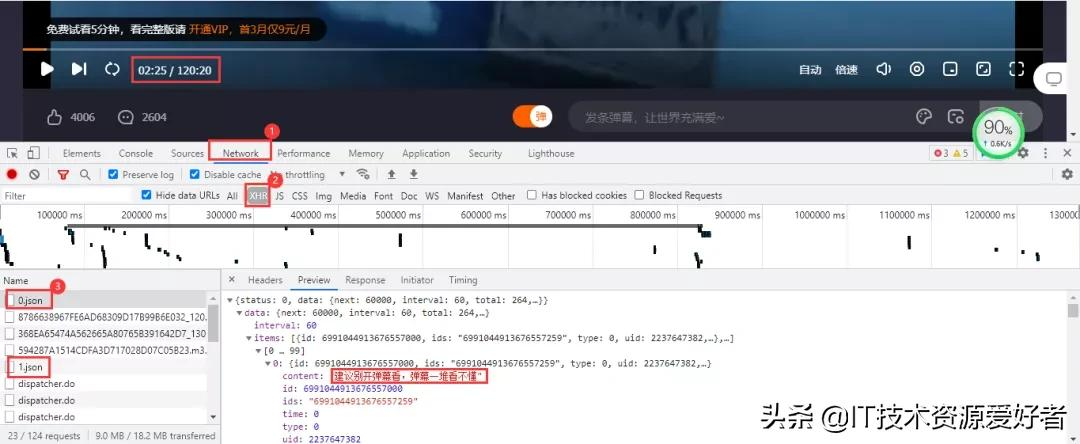
得到的真實url:
https://bullet-ali.hitv.com/bullet/2021/08/14/005323/12281642/0.json
https://bullet-ali.hitv.com/bullet/2021/08/14/005323/12281642/1.json
可以發現,每條url的差別在于后面的數字,首條url為0,后面的逐步遞增。視頻一共120:20分鐘,向上取整,也就是121條數據包。
實戰代碼
import requests
import pandas as pd
headers = {
'user-agent': 'Mozilla/5.0 (windows NT 10.0; Win64; x64) AppleWebKit/537.36 (KHTML, like Gecko) Chrome/91.0.4472.124 Safari/537.36'
}
df = pd.DataFrame()
for e in range(0, 121):
print(f'正在爬取第{e}頁')
resposen = requests.get(f'https://bullet-ali.hitv.com/bullet/2021/08/3/004902/12281642/{e}.json', headers=headers)
# 直接用json提取數據
for i in resposen.json()['data']['items']:
ids = i['ids'] # 用戶id
content = i['content'] # 彈幕內容
time = i['time'] # 彈幕發生時間
# 有些文件中不存在點贊數
try:
v2_up_count = i['v2_up_count']
except:
v2_up_count = ''
text = pd.DataFrame({'ids': [ids], '彈幕': [content], '發生時間': [time]})
df = pd.concat([df, text])
df.to_csv('懸崖之上.csv', encoding='utf-8', index=False)
結果展示:

評論
分析網頁
芒果TV視頻的評論需要拉取到網頁下面進行查看。評論數據所在的文件依然是動態加載的,進入開發者工具,按下列步驟進行抓包?.NETwork→js,最后點擊查看更多評論。
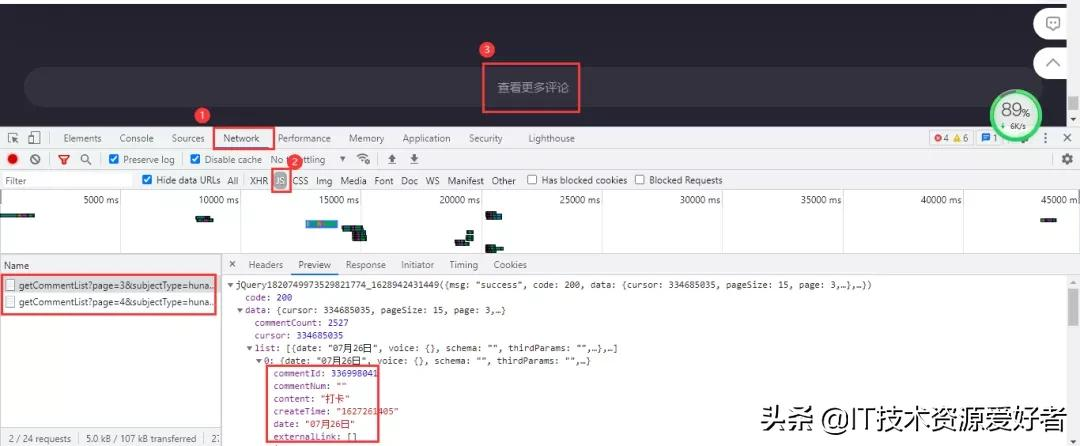
加載出來的依然是js文件,里面包含評論數據。得到的真實url:
https://comment.mgtv.com/v4/comment/getCommentList?page=1&subjectType=hunantv2014&subjectId=12281642&callback=jQuery1820749973529821774_1628942431449&_support=10000000&_=1628943290494
https://comment.mgtv.com/v4/comment/getCommentList?page=2&subjectType=hunantv2014&subjectId=12281642&callback=jQuery1820749973529821774_1628942431449&_support=10000000&_=1628943296653
其中有差別的參數有page和_,page是頁數,_是時間戳;url中的時間戳刪除后不影響數據完整性,但里面的callback參數會干擾數據解析,所以進行刪除。最后得到url:
https://comment.mgtv.com/v4/comment/getCommentList?page=1&subjectType=hunantv2014&subjectId=12281642&_support=10000000
數據包中每頁包含15條評論數據,評論總數是2527,得到最大頁為169。

實戰代碼
import requests
import pandas as pd
headers = {
'user-agent': 'Mozilla/5.0 (Windows NT 10.0; Win64; x64) AppleWebKit/537.36 (KHTML, like Gecko) Chrome/91.0.4472.124 Safari/537.36'
}
df = pd.DataFrame()
for o in range(1, 170):
url = f'https://comment.mgtv.com/v4/comment/getCommentList?page={o}&subjectType=hunantv2014&subjectId=12281642&_support=10000000'
res = requests.get(url, headers=headers).json()
for i in res['data']['list']:
nickName = i['user']['nickName'] # 用戶昵稱
praiseNum = i['praiseNum'] # 被點贊數
date = i['date'] # 發送日期
content = i['content'] # 評論內容
text = pd.DataFrame({'nickName': [nickName], 'praiseNum': [praiseNum], 'date': [date], 'content': [content]})
df = pd.concat([df, text])
df.to_csv('懸崖之上.csv', encoding='utf-8', index=False)
結果展示:
騰訊視頻
本文以爬取電影《革命者》為例,講解如何爬取騰訊視頻的彈幕和評論!
網頁地址:
https://v.qq.com/x/cover/mzc00200m72fcup.html
彈幕
分析網頁
依然進入瀏覽器的開發者工具進行抓包,當視頻播放30秒它就會更新一個json數據包,里面包含我們需要的彈幕數據。
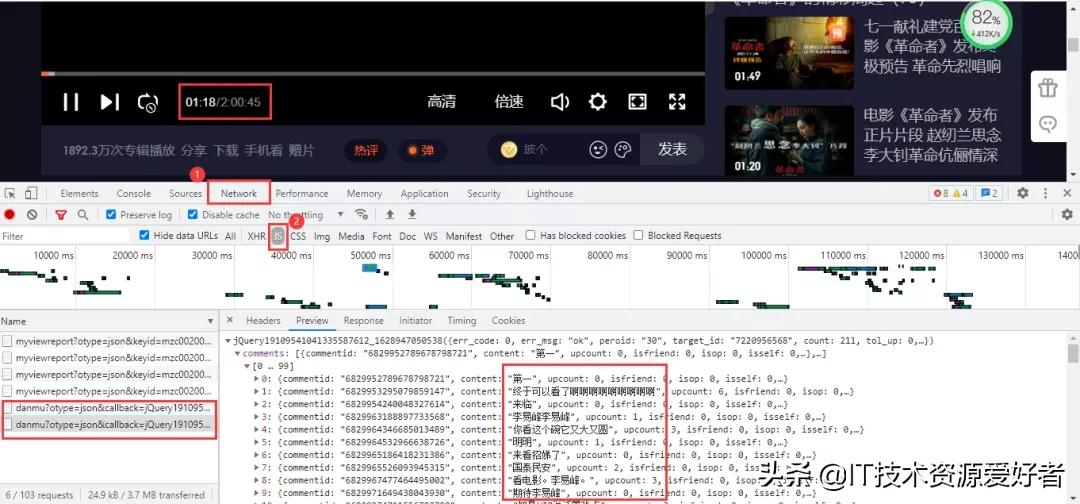
得到真實url:
https://mfm.video.qq.com/danmu?otype=json&callback=jQuery19109541041335587612_1628947050538&target_id=7220956568%26vid%3Dt0040z3o3la&session_key=0%2C32%2C1628947057×tamp=15&_=1628947050569
https://mfm.video.qq.com/danmu?otype=json&callback=jQuery19109541041335587612_1628947050538&target_id=7220956568%26vid%3Dt0040z3o3la&session_key=0%2C32%2C1628947057×tamp=45&_=1628947050572
其中有差別的參數有timestamp和_。_是時間戳。timestamp是頁數,首條url為15,后面以公差為30遞增,公差是以數據包更新時長為基準,而最大頁數為視頻時長7245秒。依然刪除不必要參數,得到url:
https://mfm.video.qq.com/danmu?otype=json&target_id=7220956568%26vid%3Dt0040z3o3la&session_key=0%2C18%2C1628418094×tamp=15&_=1628418086509
實戰代碼
import pandas as pd
import time
import requests
headers = {
'User-Agent': 'googlebot'
}
# 初始為15,7245 為視頻秒長,鏈接以三十秒遞增
df = pd.DataFrame()
for i in range(15, 7245, 30):
url = "https://mfm.video.qq.com/danmu?otype=json&target_id=7220956568%26vid%3Dt0040z3o3la&session_key=0%2C18%2C1628418094×tamp={}&_=1628418086509".format(i)
html = requests.get(url, headers=headers).json()
time.sleep(1)
for i in html['comments']:
content = i['content']
print(content)
text = pd.DataFrame({'彈幕': [content]})
df = pd.concat([df, text])
df.to_csv('革命者_彈幕.csv', encoding='utf-8', index=False)
結果展示:
評論
分析網頁
騰訊視頻評論數據在網頁底部,依然是動態加載的,需要按下列步驟進入開發者工具進行抓包:
點擊查看更多評論后,得到的數據包含有我們需要的評論數據,得到的真實url:
https://video.coral.qq.com/varticle/6655100451/comment/v2?callback=_varticle6655100451commentv2&orinum=10&oriorder=o&pageflag=1&cursor=0&scorecursor=0&orirepnum=2&reporder=o&reppageflag=1&source=132&_=1628948867522
https://video.coral.qq.com/varticle/6655100451/comment/v2?callback=_varticle6655100451commentv2&orinum=10&oriorder=o&pageflag=1&cursor=6786869637356389636&scorecursor=0&orirepnum=2&reporder=o&reppageflag=1&source=132&_=1628948867523
url中的參數callback以及_刪除即可。重要的是參數cursor,第一條url參數cursor是等于0的,第二條url才出現,所以要查找cursor參數是怎么出現的。經過我的觀察,cursor參數其實是上一條url的last參數:
實戰代碼
import requests
import pandas as pd
import time
import random
headers = {
'User-Agent': 'Mozilla/5.0 (Windows NT 10.0; Win64; x64) AppleWebKit/537.36 (KHTML, like Gecko) Chrome/91.0.4472.124 Safari/537.36'
}
df = pd.DataFrame()
a = 1
# 此處必須設定循環次數,否則會無限重復爬取
# 281為參照數據包中的oritotal,數據包中一共10條數據,循環280次得到2800條數據,但不包括底下回復的評論
# 數據包中的commentnum,是包括回復的評論數據的總數,而數據包都包含10條評論數據和底下的回復的評論數據,所以只需要把2800除以10取整數+1即可!
while a < 281:
if a == 1:
url = 'https://video.coral.qq.com/varticle/6655100451/comment/v2?orinum=10&oriorder=o&pageflag=1&cursor=0&scorecursor=0&orirepnum=2&reporder=o&reppageflag=1&source=132'
else:
url = f'https://video.coral.qq.com/varticle/6655100451/comment/v2?orinum=10&oriorder=o&pageflag=1&cursor={cursor}&scorecursor=0&orirepnum=2&reporder=o&reppageflag=1&source=132'
res = requests.get(url, headers=headers).json()
cursor = res['data']['last']
for i in res['data']['oriCommList']:
ids = i['id']
times = i['time']
up = i['up']
content = i['content'].replace('n', '')
text = pd.DataFrame({'ids': [ids], 'times': [times], 'up': [up], 'content': [content]})
df = pd.concat([df, text])
a += 1
time.sleep(random.uniform(2, 3))
df.to_csv('革命者_評論.csv', encoding='utf-8', index=False)
效果展示:
B站
本文以爬取視頻《“ 這是我見過最拽的一屆中國隊奧運冠軍”》為例,講解如何爬取B站視頻的彈幕和評論!
網頁地址:
https://www.bilibili.com/video/BV1wq4y1Q7dp
彈幕
分析網頁
B站視頻的彈幕不像騰訊視頻那樣,播放視頻就會觸發彈幕數據包,他需要點擊網頁右側的彈幕列表行的展開,然后點擊查看歷史彈幕獲得視頻彈幕開始日到截至日鏈接:
鏈接末尾以oid以及開始日期來構成彈幕日期url:
https://api.bilibili.com/x/v2/dm/history/index?type=1&oid=384801460&month=2021-08
在上面的的基礎之上,點擊任一有效日期即可獲得這一日期的彈幕數據包,里面的內容目前是看不懂的,之所以確定它為彈幕數據包,是因為點擊了日期他才加載出來,且鏈接與前面的鏈接具有相關性:
得到的url:
https://api.bilibili.com/x/v2/dm/web/history/seg.so?type=1&oid=384801460&date=2021-08-08
url中的oid為視頻彈幕鏈接的id值;data參數為剛才的的日期,而獲得該視頻全部彈幕內容,只需要更改data參數即可。而data參數可以從上面的彈幕日期url獲得,也可以自行構造;網頁數據格式為json格式
實戰代碼
import requests
import pandas as pd
import re
def data_resposen(url):
headers = {
"cookie": "你的cookie",
"user-agent": "Mozilla/5.0 (Windows NT 10.0; Win64; x64) AppleWebKit/537.36 (KHTML, like Gecko) Chrome/88.0.4324.104 Safari/537.36"
}
resposen = requests.get(url, headers=headers)
return resposen
def main(oid, month):
df = pd.DataFrame()
url = f'https://api.bilibili.com/x/v2/dm/history/index?type=1&oid={oid}&month={month}'
list_data = data_resposen(url).json()['data'] # 拿到所有日期
print(list_data)
for data in list_data:
urls = f'https://api.bilibili.com/x/v2/dm/web/history/seg.so?type=1&oid={oid}&date={data}'
text = re.findall(".*?([u4E00-u9FA5]+).*?", data_resposen(urls).text)
for e in text:
print(e)
data = pd.DataFrame({'彈幕': [e]})
df = pd.concat([df, data])
df.to_csv('彈幕.csv', encoding='utf-8', index=False, mode='a+')
if __name__ == '__main__':
oid = '384801460' # 視頻彈幕鏈接的id值
month = '2021-08' # 開始日期
main(oid, month)
結果展示:

評論
分析網頁
B站視頻的評論內容在網頁下方,進入瀏覽器的開發者工具后,只需要向下拉取即可加載出數據包:
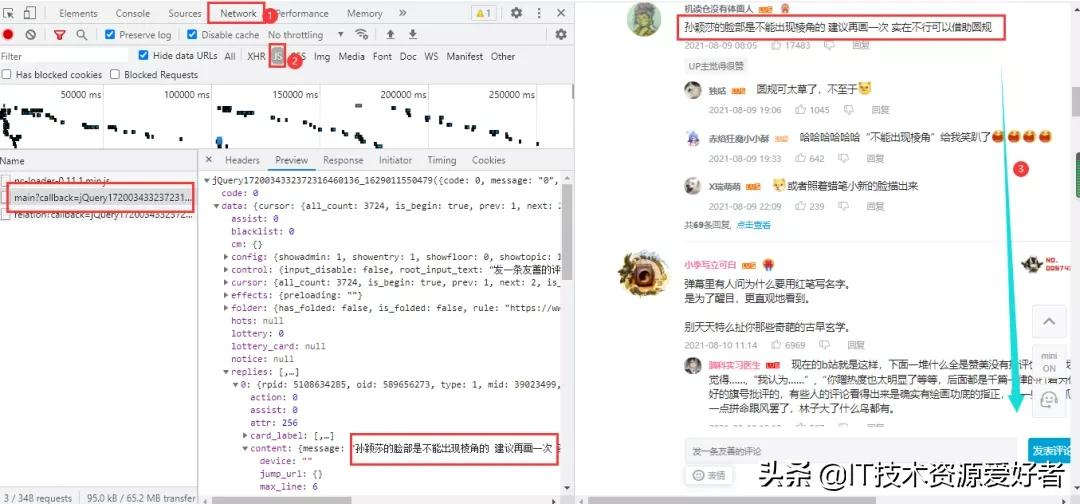
得到真實url:
https://api.bilibili.com/x/v2/reply/main?callback=jQuery1720034332372316460136_1629011550479&jsonp=jsonp&next=0&type=1&oid=589656273&mode=3&plat=1&_=1629012090500
https://api.bilibili.com/x/v2/reply/main?callback=jQuery1720034332372316460136_1629011550483&jsonp=jsonp&next=2&type=1&oid=589656273&mode=3&plat=1&_=1629012513080
https://api.bilibili.com/x/v2/reply/main?callback=jQuery1720034332372316460136_1629011550484&jsonp=jsonp&next=3&type=1&oid=589656273&mode=3&plat=1&_=1629012803039
兩條urlnext參數,以及_和callback參數。_和callback一個是時間戳,一個是干擾參數,刪除即可。next參數第一條為0,第二條為2,第三條為3,所以第一條next參數固定為0,第二條開始遞增;網頁數據格式為json格式。
實戰代碼
import requests
import pandas as pd
df = pd.DataFrame()
headers = {
'user-agent': 'Mozilla/5.0 (Windows NT 10.0; Win64; x64) AppleWebKit/537.36 (KHTML, like Gecko) Chrome/86.0.4240.111 Safari/537.36'}
try:
a = 1
while True:
if a == 1:
# 刪除不必要參數得到的第一條url
url = f'https://api.bilibili.com/x/v2/reply/main?&jsonp=jsonp&next=0&type=1&oid=589656273&mode=3&plat=1'
else:
url = f'https://api.bilibili.com/x/v2/reply/main?&jsonp=jsonp&next={a}&type=1&oid=589656273&mode=3&plat=1'
print(url)
html = requests.get(url, headers=headers).json()
for i in html['data']['replies']:
uname = i['member']['uname'] # 用戶名稱
sex = i['member']['sex'] # 用戶性別
mid = i['mid'] # 用戶id
current_level = i['member']['level_info']['current_level'] # vip等級
message = i['content']['message'].replace('n', '') # 用戶評論
like = i['like'] # 評論點贊次數
ctime = i['ctime'] # 評論時間
data = pd.DataFrame({'用戶名稱': [uname], '用戶性別': [sex], '用戶id': [mid],
'vip等級': [current_level], '用戶評論': [message], '評論點贊次數': [like],
'評論時間': [ctime]})
df = pd.concat([df, data])
a += 1
except Exception as e:
print(e)
df.to_csv('奧運會.csv', encoding='utf-8')
print(df.shape)
結果展示,獲取的內容不包括二級評論,如果需要,可自行爬取,操作步驟差不多:

愛奇藝
本文以爬取電影《哥斯拉大戰金剛》為例,講解如何爬愛奇藝視頻的彈幕和評論!
網頁地址:
https://www.iqiyi.com/v_19rr0m845o.html
彈幕
分析網頁
愛奇藝視頻的彈幕依然是要進入開發者工具進行抓包,得到一個br壓縮文件,點擊可以直接下載,里面的內容是二進制數據,視頻每播放一分鐘,就加載一條數據包:
得到url,兩條url差別在于遞增的數字,60為視頻每60秒更新一次數據包:
https://cmts.iqiyi.com/bullet/64/00/1078946400_60_1_b2105043.br
https://cmts.iqiyi.com/bullet/64/00/1078946400_60_2_b2105043.br
br文件可以用brotli庫進行解壓,但實際操作起來很難,特別是編碼等問題,難以解決;在直接使用utf-8進行解碼時,會報以下錯誤:
UnicodeDecodeError: 'utf-8' codec can't decode byte 0x91 in position 52: invalid start byte
在解碼中加入ignore,中文不會亂碼,但html格式出現亂碼,數據提取依然很難:
decode("utf-8", "ignore")
小刀被編碼弄到頭疼,如果有興趣的小伙伴可以對上面的內容繼續研究,本文就不在進行深入。所以本文采用另一個方法,對得到url進行修改成以下鏈接而獲得.z壓縮文件:
https://cmts.iqiyi.com/bullet/64/00/1078946400_300_1.z
之所以如此更改,是因為這是愛奇藝以前的彈幕接口鏈接,他還未刪除或修改,目前還可以使用。該接口鏈接中1078946400是視頻id;300是以前愛奇藝的彈幕每5分鐘會加載出新的彈幕數據包,5分鐘就是300秒,《哥斯拉大戰金剛》時長112.59分鐘,除以5向上取整就是23;1是頁數;64為id值的第7為和第8為數。
實戰代碼
import requests
import pandas as pd
from lxml import etree
from zlib import decompress # 解壓
df = pd.DataFrame()
for i in range(1, 23):
url = f'https://cmts.iqiyi.com/bullet/64/00/1078946400_300_{i}.z'
bulletold = requests.get(url).content # 得到二進制數據
decode = decompress(bulletold).decode('utf-8') # 解壓解碼
with open(f'{i}.html', 'a+', encoding='utf-8') as f: # 保存為靜態的html文件
f.write(decode)
html = open(f'./{i}.html', 'rb').read() # 讀取html文件
html = etree.HTML(html) # 用xpath語法進行解析網頁
ul = html.xpath('/html/body/danmu/data/entry/list/bulletinfo')
for i in ul:
contentid = ''.join(i.xpath('./contentid/text()'))
content = ''.join(i.xpath('./content/text()'))
likeCount = ''.join(i.xpath('./likecount/text()'))
print(contentid, content, likeCount)
text = pd.DataFrame({'contentid': [contentid], 'content': [content], 'likeCount': [likeCount]})
df = pd.concat([df, text])
df.to_csv('哥斯拉大戰金剛.csv', encoding='utf-8', index=False)
結果展示:
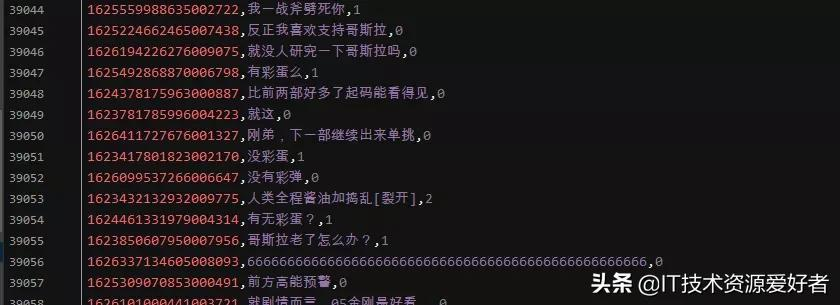
評論
分析網頁
愛奇藝視頻的評論在網頁下方,依然是動態加載的內容,需要進入瀏覽器的開發者工具進行抓包,當網頁下拉取時,會加載一條數據包,里面包含評論數據:
得到的真實url:
https://sns-comment.iqiyi.com/v3/comment/get_comments.action?agent_type=118&agent_version=9.11.5&authcookie=null&business_type=17&channel_id=1&content_id=1078946400&hot_size=10&last_id=&page=&page_size=10&types=hot,time&callback=jsonp_1629025964363_15405
https://sns-comment.iqiyi.com/v3/comment/get_comments.action?agent_type=118&agent_version=9.11.5&authcookie=null&business_type=17&channel_id=1&content_id=1078946400&hot_size=0&last_id=7963601726142521&page=&page_size=20&types=time&callback=jsonp_1629026041287_28685
https://sns-comment.iqiyi.com/v3/comment/get_comments.action?agent_type=118&agent_version=9.11.5&authcookie=null&business_type=17&channel_id=1&content_id=1078946400&hot_size=0&last_id=4933019153543021&page=&page_size=20&types=time&callback=jsonp_1629026394325_81937
第一條url加載的是精彩評論的內容,第二條url開始加載的是全部評論的內容。經過刪減不必要參數得到以下url:
https://sns-comment.iqiyi.com/v3/comment/get_comments.action?agent_type=118&agent_version=9.11.5&business_type=17&content_id=1078946400&last_id=&page_size=10
https://sns-comment.iqiyi.com/v3/comment/get_comments.action?agent_type=118&agent_version=9.11.5&business_type=17&content_id=1078946400&last_id=7963601726142521&page_size=20
https://sns-comment.iqiyi.com/v3/comment/get_comments.action?agent_type=118&agent_version=9.11.5&business_type=17&content_id=1078946400&last_id=4933019153543021&page_size=20
區別在于參數last_id和page_size。page_size在第一條url中的值為10,從第二條url開始固定為20。last_id在首條url中值為空,從第二條開始會不斷發生變化,經過我的研究,last_id的值就是從前一條url中的最后一條評論內容的用戶id(應該是用戶id);網頁數據格式為json格式。
實戰代碼
import requests
import pandas as pd
import time
import random
headers = {
'User-Agent': 'Mozilla/5.0 (Windows NT 10.0; Win64; x64) AppleWebKit/537.36 (KHTML, like Gecko) Chrome/91.0.4472.124 Safari/537.36'
}
df = pd.DataFrame()
try:
a = 0
while True:
if a == 0:
url = 'https://sns-comment.iqiyi.com/v3/comment/get_comments.action?agent_type=118&agent_version=9.11.5&business_type=17&content_id=1078946400&page_size=10'
else:
# 從id_list中得到上一條頁內容中的最后一個id值
url = f'https://sns-comment.iqiyi.com/v3/comment/get_comments.action?agent_type=118&agent_version=9.11.5&business_type=17&content_id=1078946400&last_id={id_list[-1]}&page_size=20'
print(url)
res = requests.get(url, headers=headers).json()
id_list = [] # 建立一個列表保存id值
for i in res['data']['comments']:
ids = i['id']
id_list.append(ids)
uname = i['userInfo']['uname']
addTime = i['addTime']
content = i.get('content', '不存在') # 用get提取是為了防止鍵值不存在而發生報錯,第一個參數為匹配的key值,第二個為缺少時輸出
text = pd.DataFrame({'ids': [ids], 'uname': [uname], 'addTime': [addTime], 'content': [content]})
df = pd.concat([df, text])
a += 1
time.sleep(random.uniform(2, 3))
except Exception as e:
print(e)
df.to_csv('哥斯拉大戰金剛_評論.csv', mode='a+', encoding='utf-8', index=False)
結果展示:
知乎
本文以爬取知乎熱點話題《如何看待網傳騰訊實習生向騰訊高層提出建議頒布拒絕陪酒相關條令?》為例,講解如爬取知乎回答!
網頁地址:
https://www.zhihu.com/question/478781972
分析網頁
經過查看網頁源代碼等方式,確定該網頁回答內容為動態加載的,需要進入瀏覽器的開發者工具進行抓包。進入Noetwork→XHR,用鼠標在網頁向下拉取,得到我們需要的數據包:
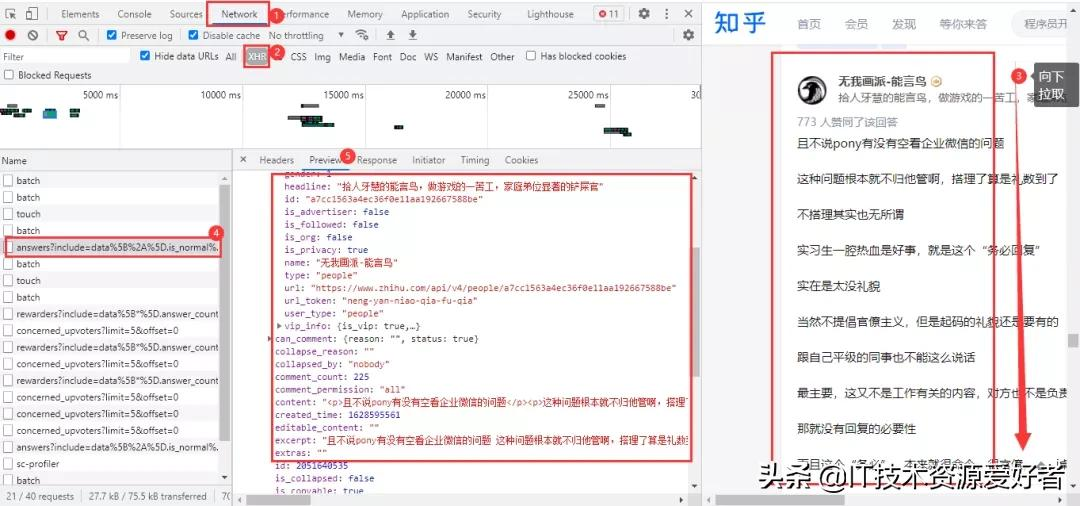
得到的真實url:
https://www.zhihu.com/api/v4/questions/478781972/answers?include=data%5B%2A%5D.is_normal%2Cadmin_closed_comment%2Creward_info%2Cis_collapsed%2Cannotation_action%2Cannotation_detail%2Ccollapse_reason%2Cis_sticky%2Ccollapsed_by%2Csuggest_edit%2Ccomment_count%2Ccan_comment%2Ccontent%2Ceditable_content%2Cattachment%2Cvoteup_count%2Creshipment_settings%2Ccomment_permission%2Ccreated_time%2Cupdated_time%2Creview_info%2Crelevant_info%2Cquestion%2Cexcerpt%2Cis_labeled%2Cpaid_info%2Cpaid_info_content%2Crelationship.is_authorized%2Cis_author%2Cvoting%2Cis_thanked%2Cis_nothelp%2Cis_recognized%3Bdata%5B%2A%5D.mark_infos%5B%2A%5D.url%3Bdata%5B%2A%5D.author.follower_count%2Cvip_info%2Cbadge%5B%2A%5D.topics%3Bdata%5B%2A%5D.settings.table_of_content.enabled&limit=5&offset=0&platform=desktop&sort_by=default
https://www.zhihu.com/api/v4/questions/478781972/answers?include=data%5B%2A%5D.is_normal%2Cadmin_closed_comment%2Creward_info%2Cis_collapsed%2Cannotation_action%2Cannotation_detail%2Ccollapse_reason%2Cis_sticky%2Ccollapsed_by%2Csuggest_edit%2Ccomment_count%2Ccan_comment%2Ccontent%2Ceditable_content%2Cattachment%2Cvoteup_count%2Creshipment_settings%2Ccomment_permission%2Ccreated_time%2Cupdated_time%2Creview_info%2Crelevant_info%2Cquestion%2Cexcerpt%2Cis_labeled%2Cpaid_info%2Cpaid_info_content%2Crelationship.is_authorized%2Cis_author%2Cvoting%2Cis_thanked%2Cis_nothelp%2Cis_recognized%3Bdata%5B%2A%5D.mark_infos%5B%2A%5D.url%3Bdata%5B%2A%5D.author.follower_count%2Cvip_info%2Cbadge%5B%2A%5D.topics%3Bdata%5B%2A%5D.settings.table_of_content.enabled&limit=5&offset=5&platform=desktop&sort_by=default
url有很多不必要的參數,大家可以在瀏覽器中自行刪減。兩條url的區別在于后面的offset參數,首條url的offset參數為0,第二條為5,offset是以公差為5遞增;網頁數據格式為json格式。
實戰代碼
import requests
import pandas as pd
import re
import time
import random
df = pd.DataFrame()
headers = {
'user-agent': 'Mozilla/5.0 (Windows NT 10.0; Win64; x64) AppleWebKit/537.36 (KHTML, like Gecko) Chrome/81.0.4044.138 Safari/537.36'
}
for page in range(0, 1360, 5):
url = f'https://www.zhihu.com/api/v4/questions/478781972/answers?include=data%5B%2A%5D.is_normal%2Cadmin_closed_comment%2Creward_info%2Cis_collapsed%2Cannotation_action%2Cannotation_detail%2Ccollapse_reason%2Cis_sticky%2Ccollapsed_by%2Csuggest_edit%2Ccomment_count%2Ccan_comment%2Ccontent%2Ceditable_content%2Cattachment%2Cvoteup_count%2Creshipment_settings%2Ccomment_permission%2Ccreated_time%2Cupdated_time%2Creview_info%2Crelevant_info%2Cquestion%2Cexcerpt%2Cis_labeled%2Cpaid_info%2Cpaid_info_content%2Crelationship.is_authorized%2Cis_author%2Cvoting%2Cis_thanked%2Cis_nothelp%2Cis_recognized%3Bdata%5B%2A%5D.mark_infos%5B%2A%5D.url%3Bdata%5B%2A%5D.author.follower_count%2Cvip_info%2Cbadge%5B%2A%5D.topics%3Bdata%5B%2A%5D.settings.table_of_content.enabled&limit=5&offset={page}&platform=desktop&sort_by=default'
response = requests.get(url=url, headers=headers).json()
data = response['data']
for list_ in data:
name = list_['author']['name'] # 知乎作者
id_ = list_['author']['id'] # 作者id
created_time = time.strftime("%Y-%m-%d %H:%M:%S", time.localtime(list_['created_time'] )) # 回答時間
voteup_count = list_['voteup_count'] # 贊同數
comment_count = list_['comment_count'] # 底下評論數
content = list_['content'] # 回答內容
content = ''.join(re.findall("[u3002uff1buff0cuff1au201cu201duff08uff09u3001uff1fu300au300bu4e00-u9fa5]", content)) # 正則表達式提取
print(name, id_, created_time, comment_count, content, sep='|')
dataFrame = pd.DataFrame(
{'知乎作者': [name], '作者id': [id_], '回答時間': [created_time], '贊同數': [voteup_count], '底下評論數': [comment_count],
'回答內容': [content]})
df = pd.concat([df, dataFrame])
time.sleep(random.uniform(2, 3))
df.to_csv('知乎回答.csv', encoding='utf-8', index=False)
print(df.shape)
結果展示:

微博
本文以爬取微博熱搜《霍尊手寫道歉信》為例,講解如何爬取微博評論!
網頁地址:
https://m.weibo.cn/detail/4669040301182509
分析網頁
微博評論是動態加載的,進入瀏覽器的開發者工具后,在網頁上向下拉取會得到我們需要的數據包:
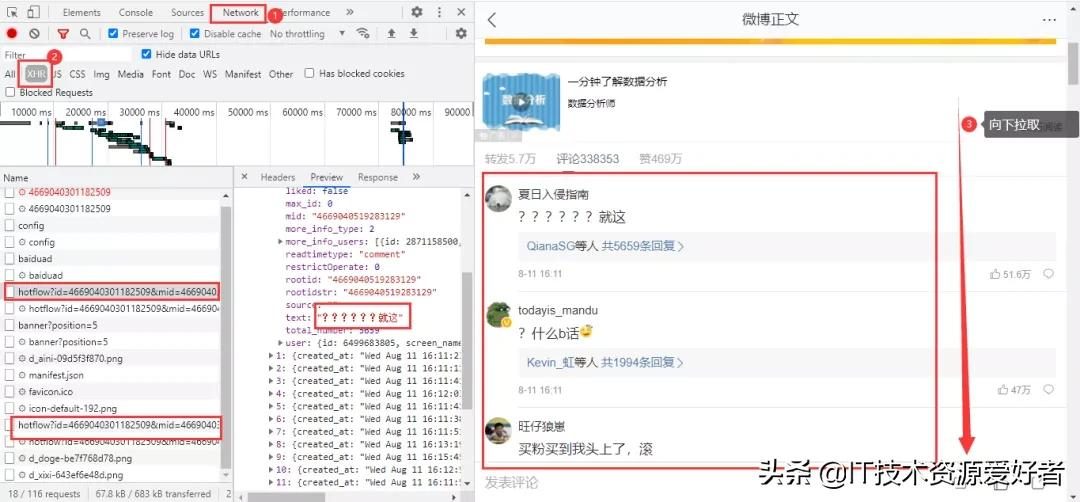
得到真實url:
https://m.weibo.cn/comments/hotflow?id=4669040301182509&mid=4669040301182509&max_id_type=0
https://m.weibo.cn/comments/hotflow?id=4669040301182509&mid=4669040301182509&max_id=3698934781006193&max_id_type=0
兩條url區別很明顯,首條url是沒有參數max_id的,第二條開始max_id才出現,而max_id其實是前一條數據包中的max_id:
但有個需要注意的是參數max_id_type,它其實也是會變化的,所以我們需要從數據包中獲取max_id_type:
實戰代碼import re
import requests
import pandas as pd
import time
import random
df = pd.DataFrame()
try:
a = 1
while True:
header = {
'User-Agent': 'Mozilla/5.0 (Windows NT 6.1; WOW64) AppleWebKit/537.36 (KHTML, like Gecko) Chrome/38.0.2125.122 UBrowser/4.0.3214.0 Safari/537.36'
}
resposen = requests.get('https://m.weibo.cn/detail/4669040301182509', headers=header)
# 微博爬取大概幾十頁會封賬號的,而通過不斷的更新cookies,會讓爬蟲更持久點...
cookie = [cookie.value for cookie in resposen.cookies] # 用列表推導式生成cookies部件
headers = {
# 登錄后的cookie, SUB用登錄后的
'cookie': f'WEIBOCN_FROM={cookie[3]}; SUB=; _T_WM={cookie[4]}; MLOGIN={cookie[1]}; M_WEIBOCN_PARAMS={cookie[2]}; XSRF-TOKEN={cookie[0]}',
'referer': 'https://m.weibo.cn/detail/4669040301182509',
'User-Agent': 'Mozilla/5.0 (Windows NT 6.1; WOW64) AppleWebKit/537.36 (KHTML, like Gecko) Chrome/38.0.2125.122 UBrowser/4.0.3214.0 Safari/537.36'
}
if a == 1:
url = 'https://m.weibo.cn/comments/hotflow?id=4669040301182509&mid=4669040301182509&max_id_type=0'
else:
url = f'https://m.weibo.cn/comments/hotflow?id=4669040301182509&mid=4669040301182509&max_id={max_id}&max_id_type={max_id_type}'
html = requests.get(url=url, headers=headers).json()
data = html['data']
max_id = data['max_id'] # 獲取max_id和max_id_type返回給下一條url
max_id_type = data['max_id_type']
for i in data['data']:
screen_name = i['user']['screen_name']
i_d = i['user']['id']
like_count = i['like_count'] # 點贊數
created_at = i['created_at'] # 時間
text = re.sub(r'<[^>]*>', '', i['text']) # 評論
print(text)
data_json = pd.DataFrame({'screen_name': [screen_name], 'i_d': [i_d], 'like_count': [like_count], 'created_at': [created_at],'text': [text]})
df = pd.concat([df, data_json])
time.sleep(random.uniform(2, 7))
a += 1
except Exception as e:
print(e)
df.to_csv('微博.csv', encoding='utf-8', mode='a+', index=False)
print(df.shape)
結果展示:

以上便是今天的全部內容了,如果你喜歡今天的內容,希望你能在下方點個贊和在看支持我,謝謝!






